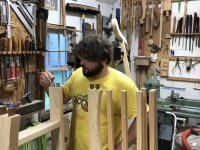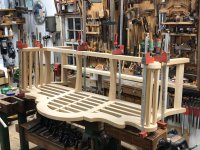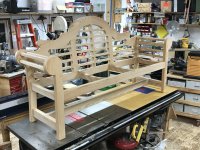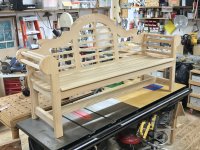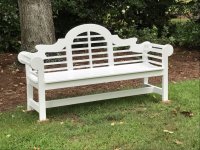Crox G
Member
- Joined
- Nov 27, 2012
- Messages
- 93
I'm making a Lutyens garden bench from Fine Woodworking plans by Tony O'Malley from issue #143, July/August 2000. I'm using cypress, available locally in clear 8/4, and Sipo tenons. This has turned out to be a challenge, and a thorough use of my treasured Domino XL700. O'Malley used a horizontal mortiser and slip tenons, so the design lent itself to the Domino. The XL was its usual solid, reliable, precise self.
I made templates from the plans for the front legs, back crest halves, and seat stretchers, and used them for my first real effort at pattern-routing in the router table. I had a Whiteside bit with bearings on the top and bottom, and a 1.5"/38mm cutting depth. The two bearings allowed me to flip the piece in order to cut downhill with the grain. I fastened the templates to the workpiece with small brads, not wanting to mess with double-sided tape.
I tried to use two dominoes at each joint if possible. If I could fit them comfortably in the biggest joints, I used 12mm. For the smallest joints for the 1"/25mm slats and arm sticks I used 6mm dominoes and cut the mortises with the Seneca adaptor. For few medium-sized joints I could get away with 8mm, which felt much stronger than the 6mm.
The back is angled back at 6 degrees, and the back legs also rake back at 6 degrees. I used different methods for aligning and cutting the mortises depending on the location. For the first time ever I held my breath and used the tight setting on all the mortises; it worked out well.
Glue-up has been a challenge, making sure that I could fit the parts together in the proper order. Many dry fits helped. I've also learned that after a section is glued, if I dry-fit that section with the next-to-be-glued parts, without gluing, the joints will align much better for the next step.
Final glue-up tonight, I hope, if I can enlist the help of my son. 24 dominoes to align at once--yikes! Apologies for the cluttered shop.
[attachimg=1]
[attachimg=2]
[attachimg=3]
[attachimg=5]
[attachimg=4]
[attachimg=6]
I made templates from the plans for the front legs, back crest halves, and seat stretchers, and used them for my first real effort at pattern-routing in the router table. I had a Whiteside bit with bearings on the top and bottom, and a 1.5"/38mm cutting depth. The two bearings allowed me to flip the piece in order to cut downhill with the grain. I fastened the templates to the workpiece with small brads, not wanting to mess with double-sided tape.
I tried to use two dominoes at each joint if possible. If I could fit them comfortably in the biggest joints, I used 12mm. For the smallest joints for the 1"/25mm slats and arm sticks I used 6mm dominoes and cut the mortises with the Seneca adaptor. For few medium-sized joints I could get away with 8mm, which felt much stronger than the 6mm.
The back is angled back at 6 degrees, and the back legs also rake back at 6 degrees. I used different methods for aligning and cutting the mortises depending on the location. For the first time ever I held my breath and used the tight setting on all the mortises; it worked out well.
Glue-up has been a challenge, making sure that I could fit the parts together in the proper order. Many dry fits helped. I've also learned that after a section is glued, if I dry-fit that section with the next-to-be-glued parts, without gluing, the joints will align much better for the next step.
Final glue-up tonight, I hope, if I can enlist the help of my son. 24 dominoes to align at once--yikes! Apologies for the cluttered shop.
[attachimg=1]
[attachimg=2]
[attachimg=3]
[attachimg=5]
[attachimg=4]
[attachimg=6]
Attachments
-
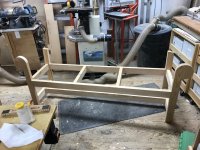 UNADJUSTEDNONRAW_thumb_11ad.jpg260.9 KB · Views: 2,135
UNADJUSTEDNONRAW_thumb_11ad.jpg260.9 KB · Views: 2,135 -
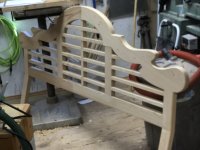 UNADJUSTEDNONRAW_thumb_11b8.jpg152.6 KB · Views: 2,072
UNADJUSTEDNONRAW_thumb_11b8.jpg152.6 KB · Views: 2,072 -
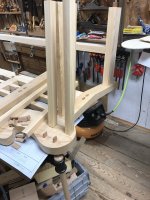 UNADJUSTEDNONRAW_thumb_11b6.jpg250.2 KB · Views: 2,024
UNADJUSTEDNONRAW_thumb_11b6.jpg250.2 KB · Views: 2,024 -
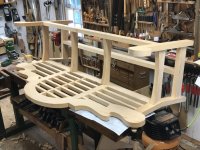 UNADJUSTEDNONRAW_thumb_11b7.jpg267.7 KB · Views: 2,048
UNADJUSTEDNONRAW_thumb_11b7.jpg267.7 KB · Views: 2,048 -
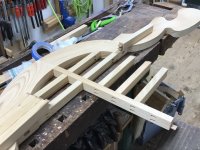 UNADJUSTEDNONRAW_thumb_11b5.jpg241.9 KB · Views: 2,071
UNADJUSTEDNONRAW_thumb_11b5.jpg241.9 KB · Views: 2,071 -
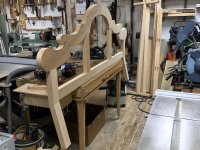 UNADJUSTEDNONRAW_thumb_11b4.jpg129.8 KB · Views: 2,064
UNADJUSTEDNONRAW_thumb_11b4.jpg129.8 KB · Views: 2,064

